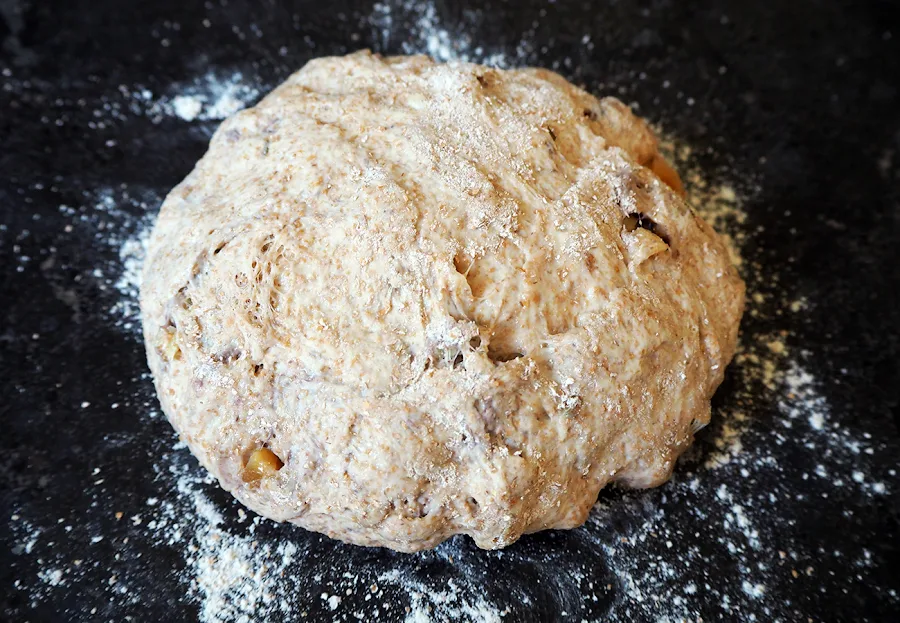This recipe is for a 100% whole spelt sourdough loaf.
I wrote in another post that a few weeks back I ordered way too much whole spelt flour. Hence I keep my eyes open for whole spelt flour recipes all the time. In fact, I pretty much make everything with spelt flour these days. Pizza crust, for example, or bread rolls.
I found this recipe for whole spelt rolls and the rolls came out fantastic. I've added pumpkin seeds, fennel seeds and ground cumin to my first batch. It inspired me to try the same dough but as a loaf and with a different flavour combination.
Spelt flour has an earthy and nutty flavour which, in my opinion, pairs particularly well with dried fruit and nuts. The addition of fennel seeds just gives this little bit of extra depth to the flavour. In Austria we traditionally spice bread with a mixture of anise, coriander, caraway and fennel seeds.
Blue cheese and thyme-blueberry jam are perfect with a slice of this bread.

When folding in the nuts and figs, make sure they are well distributed but be careful as not to squash the figs too much. You want large-ish bits of fig and nut in the finished bread. As with every bread containing dried fruit it is important to make sure that non of the fruit stick out before baking. Otherwise they will burn and are not very nice to eat. I baked the loaf in a cast iron pan, but a dutch oven works as well. If you want a harder crust, remove the lid a little earlier.

After a friend mentioned to me that he was keeping a baking journal, I recently started to do the same and keep track of kitchen temperature, humidity, rising times and such things for each bake. It's especially useful when working with sourdough as all of these parameters have an influence on the outcome. My notes on how the whole spelt rolls came out greatly helped me to work out rising times and how much spices to add. I can highly recommend this practice.
Whole spelt fig, walnut and fennel seed sourdough loaf
makes one small loaf
Ingredients
for the dough
Ingredients
for the dough
500g whole spelt flour
388g warm water, ca. 29-33°C
140g active sourdough starter, 75% hydration*
12g sea salt
2 tbsp olive oil
for the filling
15-20g fennel seeds
65-80g walnuts (coarsely chopped)
65-80g dried figs (coarsely chopped)
388g warm water, ca. 29-33°C
140g active sourdough starter, 75% hydration*
12g sea salt
2 tbsp olive oil
for the filling
15-20g fennel seeds
65-80g walnuts (coarsely chopped)
65-80g dried figs (coarsely chopped)
Directions
Day 1
Day 1
- Autolyse: In the bowl of a stand mixer mit water and flour. Cover the bowl with a plate (or plastic wrap, but I don't want to use plastic) and let rest for 40 minutes.
- Knead: Add salt, starter and olive oil and knead on low with the dough hook for about 5 minutes. Cover and let ferment for 30 minutes.
- First fold and filling: Add a third of the chopped nuts and fennel seeds. Grab the bottom of the dough and fold it over the top. Turn the bowl by 90°, add another third of the filling and fold the next side. Turn the bowl again by 90°, add the rest of the filling and fold the third side. Turn again and perform the last fold. Cover and let rest for 30 minutes.
- Second fold: Perform another set of four folds. Cover and let the dough rest for 30 minutes.
- Third fold: Perform the last set of folds.
- Slow rise: Cover the bowl with a plate (or plastic wrap) and put in the fridge or fresh drawer for 12-24 hours until doubled in size.**
Day 2
- Preshape: When the dough has roughly doubled in size and has large air bubbles on the top, take it out of the container. Shape into a ball and let rest for 20 minutes.
- Shape and proof: Shape the dough into a boule. It is not as easy because of the filling. Make sure none of the fruit stick out as they would burn. Move the dough to a floured banneton, seam side up. Let proof at room temperature for about 2 hours.
- Preheat the oven and the cast iron pan, lid on, to 230°C (top and bottom heat) about an hour before baking.
- Bake: Take the pan out of the oven, Drop the dough from the banneton into the hot pan. Slash the bread with a lame or very sharp knife. Bake with the lid on for about 25-30 minutes. Remove the lid and turn down the heat to 200°C. Bake for another 10-15 minutes. Let cool in the pan for about 10 minutes before moving the finished loaf to a wire rack to cool completely.
Notes
* I used 50/50 whole wheat and bread flour starter, but if you want to go wheat free, use a spelt flour starter.
** My fridge has a fresh produce drawer and that's where I usually put the dough for a slow rise during the night. If I want to bake during the day, I take the bowl out in the morning and let it finish rising at warm room temperature which speeds up the rise.


Comments
Post a Comment